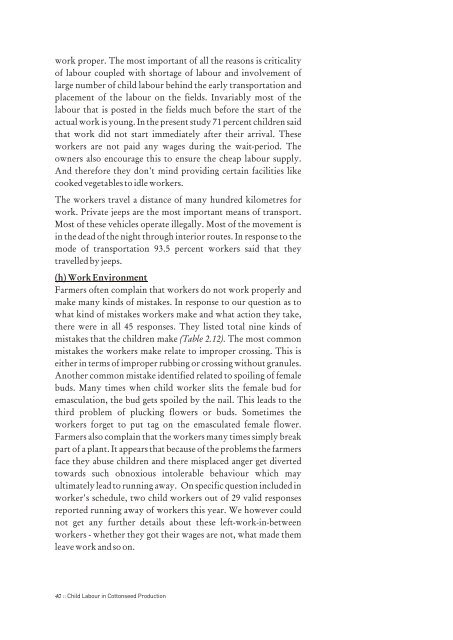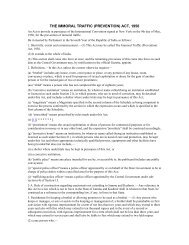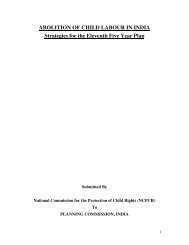Child Labour in Cottonseed Production by Ashok Khandelwal
Child Labour in Cottonseed Production by Ashok Khandelwal
Child Labour in Cottonseed Production by Ashok Khandelwal
You also want an ePaper? Increase the reach of your titles
YUMPU automatically turns print PDFs into web optimized ePapers that Google loves.
work proper. The most important of all the reasons is criticality<br />
of labour coupled with shortage of labour and <strong>in</strong>volvement of<br />
large number of child labour beh<strong>in</strong>d the early transportation and<br />
placement of the labour on the fields. Invariably most of the<br />
labour that is posted <strong>in</strong> the fields much before the start of the<br />
actual work is young. In the present study 71 percent children said<br />
that work did not start immediately after their arrival. These<br />
workers are not paid any wages dur<strong>in</strong>g the wait-period. The<br />
owners also encourage this to ensure the cheap labour supply.<br />
And therefore they don't m<strong>in</strong>d provid<strong>in</strong>g certa<strong>in</strong> facilities like<br />
cooked vegetables to idle workers.<br />
The workers travel a distance of many hundred kilometres for<br />
work. Private jeeps are the most important means of transport.<br />
Most of these vehicles operate illegally. Most of the movement is<br />
<strong>in</strong> the dead of the night through <strong>in</strong>terior routes. In response to the<br />
mode of transportation 93.5 percent workers said that they<br />
travelled <strong>by</strong> jeeps.<br />
(h) Work Environment<br />
Farmers often compla<strong>in</strong> that workers do not work properly and<br />
make many k<strong>in</strong>ds of mistakes. In response to our question as to<br />
what k<strong>in</strong>d of mistakes workers make and what action they take,<br />
there were <strong>in</strong> all 45 responses. They listed total n<strong>in</strong>e k<strong>in</strong>ds of<br />
mistakes that the children make (Table 2.12). The most common<br />
mistakes the workers make relate to improper cross<strong>in</strong>g. This is<br />
either <strong>in</strong> terms of improper rubb<strong>in</strong>g or cross<strong>in</strong>g without granules.<br />
Another common mistake identified related to spoil<strong>in</strong>g of female<br />
buds. Many times when child worker slits the female bud for<br />
emasculation, the bud gets spoiled <strong>by</strong> the nail. This leads to the<br />
third problem of pluck<strong>in</strong>g flowers or buds. Sometimes the<br />
workers forget to put tag on the emasculated female flower.<br />
Farmers also compla<strong>in</strong> that the workers many times simply break<br />
part of a plant. It appears that because of the problems the farmers<br />
face they abuse children and there misplaced anger get diverted<br />
towards such obnoxious <strong>in</strong>tolerable behaviour which may<br />
ultimately lead to runn<strong>in</strong>g away. On specific question <strong>in</strong>cluded <strong>in</strong><br />
worker's schedule, two child workers out of 29 valid responses<br />
reported runn<strong>in</strong>g away of workers this year. We however could<br />
not get any further details about these left-work-<strong>in</strong>-between<br />
workers - whether they got their wages are not, what made them<br />
leave work and so on.<br />
40 :: <strong>Child</strong> <strong>Labour</strong> <strong>in</strong> <strong>Cottonseed</strong> <strong>Production</strong>





